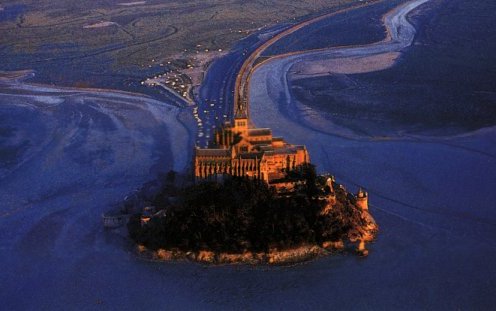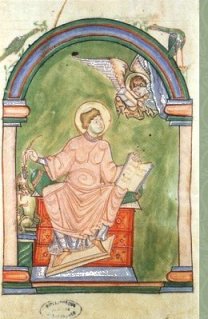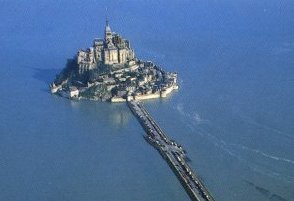
 |
Rising
up from an indefinable point in the sand and waves, Mont-Saint-Michel
appears like a human challenge to the elements and time. A lost rock in
a landscape otherwise made featureless by the power of the wind. Perched on its summit, the abbey is an invitation to come and discover its builders' wild inspiration - one which has driven so many to make this isolated place a universal meeting point for 708 years. From up there, everything comes as a surprise: the amazing feats of medieval architecture |
||
| the
power of nature, the light... No one can stay indifferent to the
message delivered by this edifice. Listed by UNESCO as part of the World
Heritage, the abbey of Mont Saint Michel is the monument for everyone.
|
|||
 |
At the beginning :
How the cult of St. Michel came into being is told in a Xth century manuscript, "La Revelatio ecclesiae sancti Michaelis". According to this original document, one night in
708, Aubert, Bishop of Avranches had a dream in which he saw the Archangel Michael who commanded him to build a church on the rock. And when the bishop dared to express doubts, the Archangel thrust a finger through his skull!
 The Builders
:
The Builders
:
Aubert therefore had a chapel erected on the site. In the troubled and uncertain times of the Merovingian era, the faithful were quick to embrace the cult of the Archangel and the rock became a place of pilgrimage, soon to be known as Mont-Saint-Michel.
The Mount became part of Normandy in 933, and the number of pilgrims steadily grew from the XIth century on, as the number of miracles recorded there increased.
Donations and legacies enabled the monks to build a Roman abbey with a large church on the very summit of the rock considered as the image of the Heavenly Jerusalem on earth. By the end of the XIIth century, the number of Benedictine monks living there had risen to 60.
In 1204, the Capetian King Philippe Auguste took the Duchy of Normandy and the Mont Saint Michel by force, which caused some damage to the
edifice. To make amends, the King ordered restoration work to be carried out and had new buildings
erected, so that the work on Mont Saint Michel seemed never-ending.
During,the Hundred Years' War (XVth century), the English sieged and assaulted the island many times. But to no avail. The abbey's defences were reinforced and the Mont Saint Michel remained invulnerable
 The dark days of the Mont Saint Michel :
The dark days of the Mont Saint Michel :
In the XVIth century, the Mont began to fall into disrepair due to a lack of maintenance work and the decline of the monastic life.
The situation was made worse by Protestant attacks during the Religious Wars, so that by the end of the XVIIIth century less than a dozen monks remained.
In 1793, the revolutionaries turned the abbey into a prison, and it was not until
1863 that an imperial decree put an end to this sacrilege.
 |
The Renewal of the Mont : Since 1983, the upkeep and enhancement of the monument have been the responsibility of Pierre-André Lablaude. |
-
The Mont Saint Michel is an village, you can always have access to it, but the abbey can be visited only on opening hours. Take care of the tide, the parking is frequently flooded and exceptionally, the road too.
The Abbey is Open :
From May 2 to September 30 :
9 Am - 5:30 Pm
From October 1 to April 30 :
9:30 Am - 4:30 Pm
(5 Pm on school holidays)
The Abbey is Closed :
on January 1, May 1, November 1, November 11 and December 25








